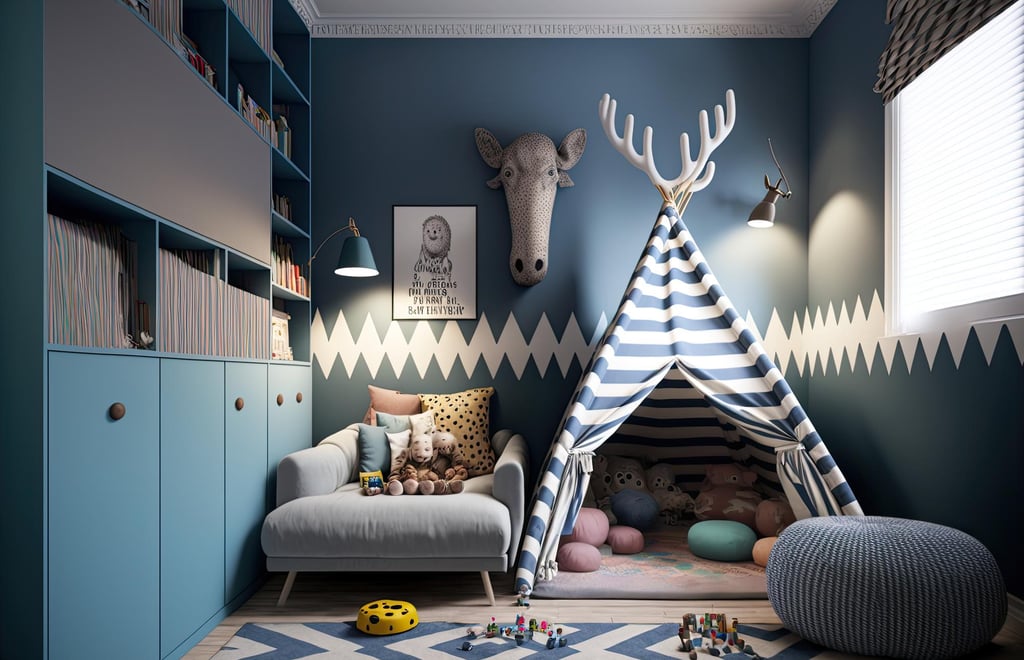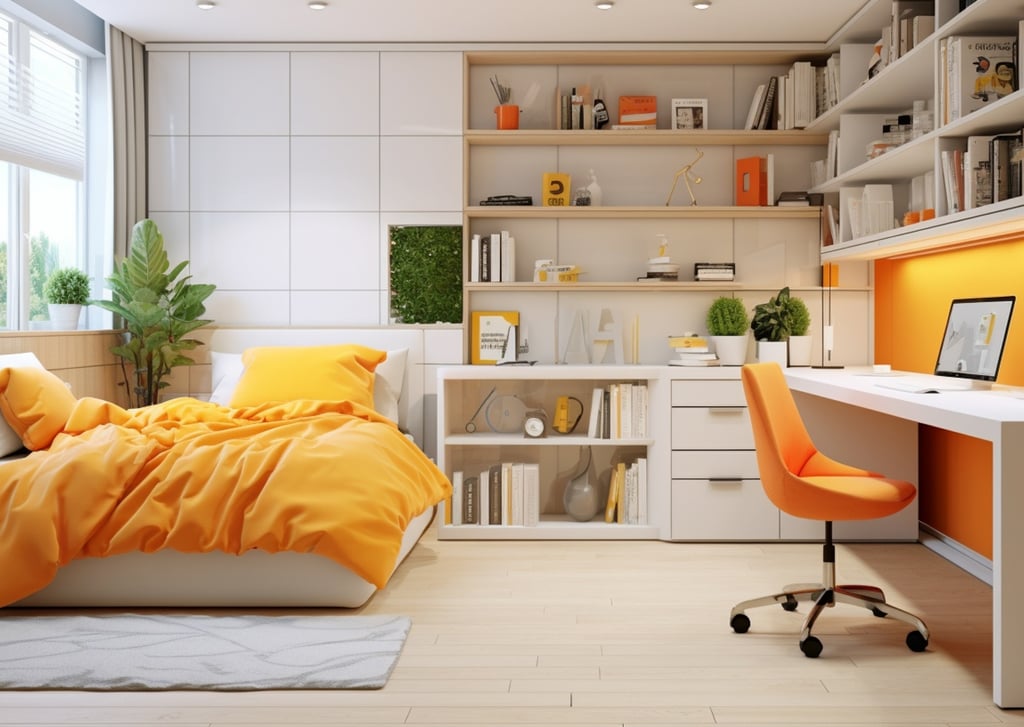Nurturing Wonders: Designing Inspiring Spaces for Growing Minds, Kids Room
DESIGN
Designing a child's room is one of the most rewarding and imaginative challenges in home interior design. It's not just about creating a pretty space; it's about crafting an entire environment that acts as a catalyst for growth, learning, creativity, and comfort. A well-designed children's space goes far beyond a bed and a dresser; it becomes a personal universe where adventures unfold, dreams take flight, and independence takes root.
Kids' needs evolve at lightning speed. What captivated a toddler won't necessarily engage a school-aged child, and a teenager certainly has different requirements. This dynamic nature means that flexibility and foresight are key. Rather than designing for a fleeting phase, aim for a space that can adapt, morph, and mature alongside its inhabitant. Think of it as an ongoing project, where elements can be swapped, added, or repurposed to meet their ever-changing interests and developmental stages.
The Cornerstone Principles of Kid-Centric Design
Safety is Non-Negotiable: The Unseen Foundation:
TBefore a single paint swatch is considered, safety must be your absolute top priority. This means anchoring heavy furniture like dressers and bookshelves to the wall to prevent tipping accidents. Opt for non-toxic, low-VOC (Volatile Organic Compound) paints and finishes, ensuring the air your child breathes is clean. Look for furniture with rounded corners to minimize bumps and bruises. Secure blinds and curtain cords out of reach to prevent strangulation hazards. And, of course, cover all electrical outlets with child-proof covers. Regularly check for small items that could be choking hazards for younger children, especially if older siblings share the space.
Fuelling Imagination and Unstructured Play:
A child's room should be a launchpad for their creativity. Think beyond just having toys; design elements that actively invite imaginative play. Consider a chalkboard or whiteboard wall for endless drawing and scribbling, or a designated dress-up corner complete with a small mirror and costume bin. A cozy reading nook with soft cushions and a canopy can transform into a secret fort or a magical hideaway. Open-ended toys, like building blocks, art supplies, or dollhouses, encourage children to invent their own narratives, fostering problem-solving and critical thinking.
Cultivating Independence and Easy Access:
Empowering children means enabling them to do things for themselves. Design the room so items are within their reach. Install low-level shelves for books and toys, making cleanup a more manageable task for them. Use hooks at their height for coats, backpacks, or dress-up clothes. Choose clothing storage solutions that are easy for little hands to navigate, like baskets or drawers they can open independently. When children can access their belongings and participate in tidying, it builds confidence, responsibility, and a sense of ownership over their space.
The Power of Flexibility and Adaptability:
Did you know that different light temperatures can alter how colors appear? Warm light can make cool colors seem duller and warm colors richer, while cool light can make warm colors appear muted and cool colors more vibrant. It's crucial to consider your lighting choices in conjunction with your color palette to ensure your chosen hues are accurately represented.
Enhancing Functionality
Your child won't stay the same size, nor will their interests remain static. Invest in convertible furniture, such as cribs that transform into toddler beds and then full-sized beds, or adjustable desks and chairs that grow with them. Modular storage units are incredibly versatile; they can be reconfigured as storage needs change or even repurposed for different rooms. Opting for neutral base colors on walls and larger furniture items provides a timeless backdrop that can easily be updated with new bedding, accessories, and wall art as their preferences shift from dinosaurs to outer space, or from princesses to pop stars.




Defining Zones for Diverse Activities:
Even in a compact room, you can create distinct zones that serve different purposes. This helps children understand the function of each area and can improve focus. Use a soft, plush rug to define the play zone, distinguishing it from the harder flooring of a study area. A desk and chair clearly mark the study zone, while a comfortable armchair or beanbag can designate a reading and relaxation corner. Even subtle changes in lighting or wall decor can help delineate these spaces, creating a sense of order and purpose within the room.
Smart Storage: The Unsung Hero of Kids' Rooms:
Let's be honest: kids accumulate a lot of stuff! Effective, easily accessible, and ample storage is the unsung hero of any child's room. Think vertically with wall-mounted shelves or cubby systems. Under-bed storage drawers are perfect for stashing extra bedding, out-of-season clothes, or less-used toys. Bins, baskets, and clear containers are excellent for organizing smaller items and making cleanup a breeze. The trick is to have a place for everything, and ideally, for everything to be easily returned to its place. Involve your child in the organizing process; it teaches them valuable life skills and fosters a sense of responsibility.
Infusing Personality and Personal Touches:
While you might have a vision, remember whose sanctuary this is! Allow your child to have significant input on the colour palette, themes, and decorative accents. This doesn't mean letting a five-year-old dictate every design decision, but it does mean incorporating their favourite colours, displaying their artwork prominently, dedicating a shelf to their treasured collections, or even choosing bedding with their favourite characters. When a child's personality is reflected in their room, it fosters a deeper sense of belonging, comfort, and pride. It truly becomes their space.
Designing a child's room is a dynamic and joyful endeavour. By thoughtfully considering safety, fostering imagination, promoting independence, embracing adaptability, structuring zones, maximizing storage, and above all, infusing their unique personality, you'll create a vibrant, functional, and inspiring environment where your child can truly flourish.
FOQ
Q1. How often should I redesign my child's room?
A1. Full redesigns aren't always necessary. Focus on adaptable elements. Minor refreshes (changing bedding, adding new artwork or storage) can happen every 1-2 years, while major changes (like transitioning from a crib to a bed, or adding a desk) might be every 3-5 years, or as their needs significantly change.
Q2. What's the best way to choose a color scheme for a kid's room?
A2. Consider starting with a neutral base for walls and larger furniture, which provides flexibility. Then, introduce pops of color through accessories, bedding, and removable decals. Involve your child in choosing their favorite colors, but guide them towards options that won't quickly go out of style or become overwhelming.
Q3. How can I make a shared kids' room functional and fair?
A3. Define individual spaces for each child using rugs, room dividers (like bookshelves), or different color accents for their respective areas. Provide equal and accessible storage for each child's belongings. Discuss and agree on shared rules for the common areas.
Q4. Are themed rooms a good idea for kids?
A4. Themed rooms can be fun, but choose themes that can easily evolve or are not overly specific. Instead of painting a permanent mural, use themed bedding, wall decals, or accessories that can be easily changed as interests shift. This prevents the room from feeling dated quickly.
Q5. What is some budget-friendly tips for designing a kid's room?
A5. Look for multi-functional furniture (like beds with built-in storage). DIY projects for decor or storage can save money. Repurpose existing furniture with paint. Shop for deals at second-hand stores or online marketplaces for gently used items, especially for larger pieces.



